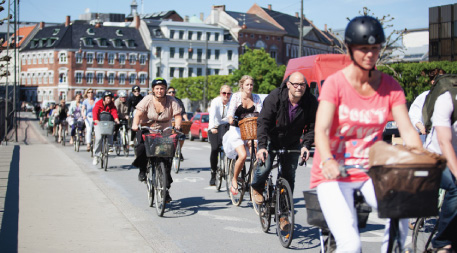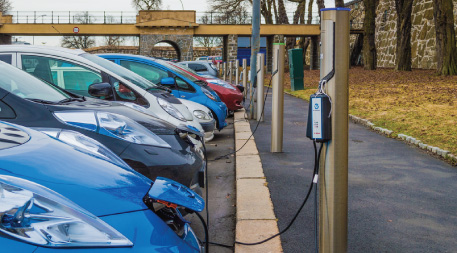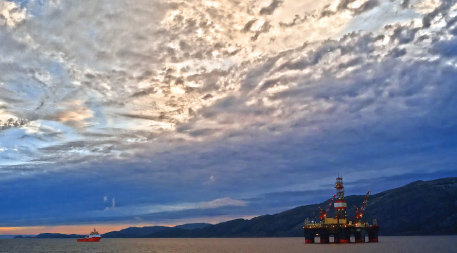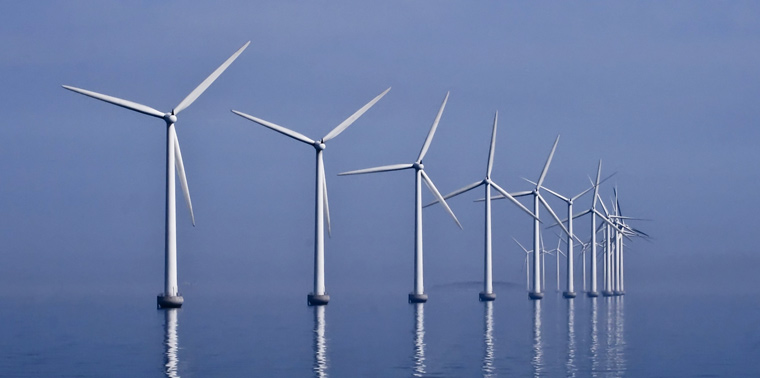December 9, 2013 — From a window seat, the first glimpse of Denmark’s sustainability ambition waves at air travelers as they make their descent into Copenhagen’s airport. Middelgrunden, a row of 20 towering turbines audaciously anchored to a reef more than a mile from dry land, was the world’s largest offshore wind farm when it was built in 2000. Today, along with Copenhagen’s famous bicycle scene, these blades remain among the most visible signs of a decades-long green transition underway in this city, which aspires to be the world’s first carbon-neutral capital in 2025.
It’s big goals and big investments like these that have helped give Denmark and its neighbors Norway and Sweden an outsized presence in the sustainability world. As it sheds a dirtier, oil-dependent past, Scandinavia has become a mecca for green energy, design and policy, boasting some of the world’s most efficient buildings, lowest fossil fuel use and boldest emission targets.
Yet, exceptional as these Scandinavian countries appear — and they certainly are above average — each also faces significant questions and contradictions as it attempts to minimize its impact on the climate and planet.
Denmark, for example, is home to some of the world’s most efficient buildings and best bicycle infrastructure — but it also has the baggage of a wealthy, consuming nation with a per-capita ecological footprint that tops that of the United States.

Thanks in large part to Denmark’s massive push for energy conservation in the wake of the 1973 Arab oil embargo, Copenhagen has become renowned worldwide for its bicycling culture. Photo ©iStockphoto.com/MivPiv.
Sweden’s energy mix has one of the lowest proportions of fossil fuels in the world — but instead Swedes rely on nuclear, hydropower and wood fuels, all of which are environmental mixed bags.
Meanwhile, oil-rich Norway has become an unlikely global leader in electric vehicles, powered by its abundant hydropower — but the country is also the world’s third-largest exporter of oil and gas.
Denmark: Transformation Trigger
It was a sudden shortage of oil that triggered Denmark’s transformation into one of the most efficient economies in the world. The 1973 Arab oil embargo led to shortages and skyrocketing prices that brought the Danish economy to its knees. At the time, the country counted on oil — almost all of it imported — for more than 90 percent of its energy.
“We found out how vulnerable we are,” says Iver Høj Nielsen, head of press for State of Green, a public-private partnership that promotes Danish sustainability solutions to the rest of the world.
The experience would change the country’s course for decades.
Denmark’s GDP per unit of energy today is almost twice that of the United States.Saving energy became an overnight priority. The country built hundreds of district heating systems — networks of pipes that carry heat from centralized power plants — to replace less-efficient heating oil furnaces in homes and businesses. It used taxes, subsidies and strict building codes to steer homeowners and builders toward better insulation and more efficient appliances. And car-free Sundays during the crisis brought bicycles to the streets and seeded the public demand for the two-wheeled infrastructure that would come to define its cities.
As a result, Denmark’s total final energy consumption in 2009 was actually slightly lower than it was in 1973, even though the country’s economy has nearly doubled in size since then. Denmark’s GDP per unit of energy today is almost twice that of the United States, and among countries in the OECD it trails only Ireland, Switzerland and the United Kingdom.
The oil crisis and subsequent search for alternatives also gave birth to the modern wind power industry. Vestas’ and Siemens’ wind units started here in 1979 and 1980, respectively. Wind power now provides more than 30 percent of Denmark’s electricity, and energy technologies account for about 11 percent of Denmark’s exports.
Sweden: Wood & Waste
Sweden, too, was deeply affected by the 1970s oil crisis. At the time, the Swedes relied on oil for about 75 percent of their total energy supply, despite the fact Sweden produces no domestic oil. The country’s response to the crisis was a pivot toward natural resources that it does have — specifically wood, water and uranium.

Växjö’s ambitious efforts to convert from oil to renewable fuels helped earn it the title of the Greenest City in Europe in 2007. Photo courtesy of University of Northern British Columbia.
“We suddenly were facing enormous prices on oil and had no control of them whatsoever,” says Johan Thorsell, business support manager for the city of Växjö, in southern Sweden. “We started to ask: What kind of resources do we have locally? Well, we have wood.”
Växjö is a city of about 80,000 tucked into Sweden’s Småland forests. With its abundant trees and lakes, residents are never far from nature. Along with a major university, the forest industry has long been one of the region’s most important employers.
In 1980, Växjö began replacing oil in its municipal power plant with wood chips and other waste products left over from area logging and sawmill operations. It was the first city in Sweden to convert its district heating system to run on biomass. Today, wood fuels supply about 90 percent of the city’s heating and cooling energy.
The rest of Sweden is steadily catching up, spurred by a carbon tax that took effect in the early 1990s. Most cities have district heating systems, and biomass accounted for 47 percent of energy input in 2011 — by far the largest source, followed by municipal solid waste at 20 percent.
While fossil fuels play a diminishing role in heating, they’re virtually nonexistent in the electricity sector. Sweden built a dozen nuclear reactors in the 1970s and ’80s to supplement its massive hydropower capacity. Together the two sources meet up to 90 percent of the country’s load.
Among International Energy Agency members, no other country uses a smaller share of fossil fuels. As Sweden works towards a goal of zero net greenhouse emissions by 2050, its biggest challenge will be transportation, which accounts for nearly half its emissions today.
Norway: Electrified
For a road map to electrifying vehicles, Sweden may need to look no further than Norway. In September 2013, the all-electric Tesla Model S became the best-selling car in Norway.

A slew of tax breaks, free parking and other incentives have helped make electric cars a common sight in Norway. Photo by C.Bry@nt (Flickr / Creative Commons).
Norwegians’ interest in electric cars is being driven by a slew of tax breaks and other perks, including free parking, toll exemptions and access to bus lanes. The country was on track to have about 15,000 electric cars on the road by the end of 2013 — 10 times the number in Denmark or Sweden.
These EVs have a nearly carbon-free fuel source, too, because almost all of Norway’s electricity comes from hydropower. “We don’t use oil and gas in our heating or electricity sectors,” says Janne Stene, head of the clean energy team at the Bellona Foundation, an Oslo-based environmental non-governmental organization. “We’re not dependent on it in the same way other countries are.”
Sustainability Paradox
Norway is still very dependent on oil and gas, however — just, as Stene says, not in the same way. Oil and gas may not fuel its power plants, but they certainly fuel its economy, accounting for more than 23 percent of the country’s GDP.

Fossil fuel exports made possible by oil rigs like this one just outside Norway’s fjords complicate the sustainability landscape for a country that derives much of its own energy from renewable sources. Photo by Andy Beal Photography (Flickr / Creative Commons).
Norway’s status as the world’s third-largest exporter of oil and gas behind Russia and Saudi Arabia complicates its ambitious environmental aspirations. The country aims to be carbon-neutral by 2050, but can it really be sustainable as long as it’s enabling oil addictions elsewhere?
Denmark’s sustainability paradox stems not from what it exports but from what it imports.
As busy as Copenhagen’s bike lanes are, none gets as much use as the Strøget, the city’s two-mile-long, car-free shopping district. The outdoor mall draws an estimated 250,000 visitors per day in the summer. The oldest public squares in the city are now nodes connecting row after row of fashion boutiques, chain stores and sidewalk cafés.
While Danish consumerism may be more conscious and less compulsive than the American version, make no mistake: Danes like to shop. Copenhagen is a cosmopolitan city with booming foodie and fashion scenes. And thanks to the country’s progressive wealth distribution policies, most people can afford to buy nice things.
All of that consumption adds up — sometimes in ways that don’t show up in official sustainability metrics. The most commonly cited statistics on carbon emissions, for example, show Denmark’s per capita carbon footprint trending downward since the mid-1990s. “This is something Danish politicians love to talk about, because they say this shows how we have been able to decouple economic growth from CO2 emissions,” says Thomas Færgeman, director of CONCITO, a climate change think tank based in Copenhagen.
While reality is messier than the region’s green image, Scandinavia clearly offers success stories and lessons for the rest of the world.
As a small country that depends heavily on imports, however, Denmark’s impact isn’t accurately reflected by these official numbers, he says, which generally focus on the impact of goods produced in a country. CONCITO has done its own carbon footprint calculation based on what Denmark consumes, rather than what it produces. “It’s about 50 percent higher than the official numbers,” says Færgeman, and “it’s actually rising.”
Denmark’s appetite for meat and global goods contributed to its fourth-worst ranking in a 2012 report by WWF and the Global Footprint Network on the ecological footprint of nations. On a per capita basis, only three countries — Qatar, Kuwait and the United Arab Emirates — are depleting the planet’s resources faster, according to the report. (The United States ranked fifth worst.)
Lessons for the Rest of Us
While reality is messier than the region’s green image, Scandinavia clearly offers success stories and lessons for the rest of the world. It’s a leader in energy-efficient buildings and bike and transit infrastructure. It has some of the world’s cleanest air and water, and most aggressive and broadly supported climate goals.
When Denmark’s parliament passed an ambitious law in March 2012 to accelerate progress toward a 100 percent renewable energy goal, it passed just eight votes shy of being unanimous — something that seems unimaginable in the U.S. Congress. Why is it that the lessons of the 1970s oil crisis stuck in Scandinavia while other countries forgot? How have Scandinavian countries managed to move forward without the distraction of climate denialism or industry opposition?
“We all talk to each other and have a common understanding.” — Katherine RichardsonThe answer may have to do with the countries’ small size and relative homogeneity. Scandinavians know they don’t have resources to waste. They’ve long been dependent on trade with others, more so than larger countries. Most citizens come from similar cultural backgrounds, and there are no extreme gaps in wealth to create factions, so it’s relatively easy to build consensus.
“These sustainability challenges demand we come together,” says Robert Strand, director of the Scandinavian Centre for Corporate Sustainability at the Copenhagen Business School. And that’s something Scandinavians have proven to be particularly good at. The region has a long history of multi-party governments that depend on compromise to get things done, as well as a tradition of cross-sector collaboration among government, academia and private industry.
“We all talk to each other and have a common understanding,” says Katherine Richardson, leader of the Sustainability Science Centre at the University of Copenhagen. That’s allowed the region to set ambitious, long-term sustainability goals, and to stick with them even through changes in government.
And then there’s plain old pride — the good kind. When the BBC in 2007 set out to find the “greenest city in Europe,” it’s no surprise its search ended in Scandinavia. The network spotlighted efforts in Växjö to phase out fossil fuels, reduce energy use and clean up lakes. The recognition prompted the city to pass a more ambitious and comprehensive environmental program, and to this day it’s still trying to live up to its designation as Europe’s greenest.
“This is nothing that we are finished with,” says the city’s environmental coordinator, Henrik Johansson. “We can never say that we have succeeded — at least not yet.” ![]()
Dan Haugen is a freelance journalist who recently traveled to Scandinavia as part of the Heinrich Böll Foundation’s Climate Media Fellowship program.
Ensia shares solutions-focused stories free of charge through our online magazine and partner media. That means audiences around the world have ready access to stories that can — and do — help them shape a better future. If you value our work, please show your support today.
Yes, I'll support Ensia!

http://energypriorities.com/2011/12/sustaindinavia-copenhagens-integrated-approach-to-energy/